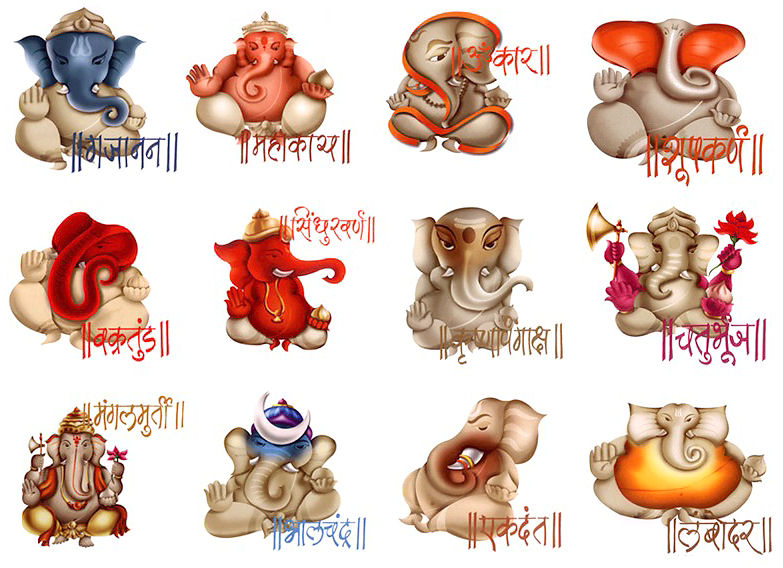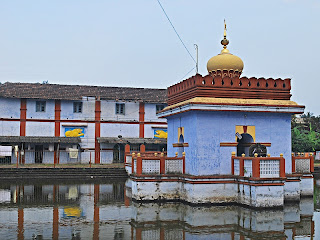OmkAreshwar is a beautiful self manifest (swayambhu) linga. From the Vindhyanchal mountain range in Madhya Pradesh, river Narmada, turns westward and meanders in that direction. The deep wide river looks like it has assimilated into itself all the sins and sorrows of the humans and releasing them from these. This river Narmada, which flows rippling from the mountains, is also known as “Reva”. The smooth, round pebbles found in this river are called “BanaLingas”.
“Narmada ke Kankar, UtteShankar” is the belief of the devotees. That is how, Narmada is also known as “Shankari” river.
On the banks of river Narmada, there is a huge island on which the fourth of the JyotirLinga “Omkaram Amaleshwar” is situated. This island and the river are shaped like “OM” and that is how it derives its name. It is a natural phenomenon. The devotees who go round the temple consider themselves blessed because they are doing a Parikrama or Circumambulation of Omkara itself and Darshan of the holy JyotirLinga. The Narmada banks and the island are extremely beautiful. The beauty of Nature here is seen to be believed. The houses perched on the terraced green, strong mountains, the temple, KotiTeerth located in the waterfalls and valleys like Chakrateerts are some of the places to be seen. One can see very big fish and also crocodiles in these waers. There are many trees with beautiful creepers all over them. Groups of monkeys live on these trees. There are a variety of birds. The temple towers look bright and shiny in between. The whole atmosphere echoes with the the sound of “Om Namah Shivaya”. It is here that Lord Sankara has taken the forms of “Omkareshwara” and “Amaleshwara”, as JyotirLinga.
In the ancient times the Demons defeated the gods or divines. Indra was worried. The Danavas or Demons have wrecked havoc in all the three worlds, i.e., Trilokas. In order to empower the Devas once again, Lord Shiva assumed the form of Jyotirmaya Omkararoop. He came out of the nether world or Patala. Lord Shankar came out in the form of Linga on the banks of river Narmada. The gods or Devas have worshipped the Linga which made them powerful once again. This time they were able to destroy the demons and re-acquiesced their empire in Heavens.
Brahma and Vishnu also lived in the same place as Omkar Amaleshwar. That is why on the banks of Narmada Brahmapuri, Vishnupuri and Rudrapuri are built which are known as Tripuri Kshetra. The Amareshwar JyotiraLinga is situated in Rudrapuri.
Later on, in the mythological era or Purana Kala, Yavanaswa Putra Mandhata came into power here with the blessings of Indra. He served Lord Shankara with great devotion. Lord Shankara was pleased with him. The waters of Narmada emanated from the Arghya (holy water) or Jalahari of the Omkar JyotirLinga and flown through the mountains, downward and later on flow unseen. Narmada joins the deep-water spring located near the Linga idol of Omkareshwar. It flows there eternally. When some bubbles appear at the bottom of this spring, it is said, that Lord Shankar is pleased.
King Mandhata made this holy place his capital. Therefore, this place is also known as Omkar Mandhata. The descendents of Mandhata live here even today. The Vindhya mountain also performed a severe penance and pleased Omkar-Amareshwar. As a result of which, the whole place turned beautiful. Many hermits like Agastya have performed severe penances and japas at Omkar-Amaleshwaram JyotirLingam. They had built their hermitages.
This place of pilgrimage became famous in the historical times too. In 1063 AD, Paramarking Udayaditya installed four stone inscriptions with four Sanskrit Stotras and dedicated them to the Amaleshwar Temple. Pushpadanta’s “Shiva Mahima Stotra” can also be seen as a stone inscription.
Initially aboriginals used to live here on Omkareshwar island as a settlement. It belonged to Kalika devi. Devotees of this goddess were known as Bhairavgan and used to harass pilgrims. They used to sacrifice them. After sometime, a saint by the name Dariyayinath took charge of that place and stopped the atrocities of the Bhairavgan. Since then, pilgrims started moving there freely.
After that, Bhil reign began there. In 1195 AD, King Bharat Singh Cahuhan won over the Bhils and improved the grandeur of the Omkar Mandhata. Even today the palace ruins of Raja Bahrat Singh Chauhan can be seen. The heirs of Bharat Singh Chauhan call themselves the ‘Kings’ of Omkar island, even now staking their right.
The temple was renovated by Peshwa Baji Rao, the second. After Peshwa, Punyashlok Ahilya Devi Holkar, has made several improvements in this ancient shrine. She built strong, expansive and beautiful ghats. The important one among there is the KotirLingarchana schedule.
This shrine of Omkar Mandhata Shiva pilgrimage is most beautiful. According to Shankaracharya. It is:
kAverikAnarmadayoH pavitre samAgame sajjanatAraNAya |
sadaiva mAndhAtRipure vasantamoNkAramIshaM shivamekamIDe ||
Meaning:
I pay my obeisance to the One Who is the savior of the good people and the great One Who always resides at the Holy merging point of Kaveri and Narmada, i.e., Omkar Shiva.















